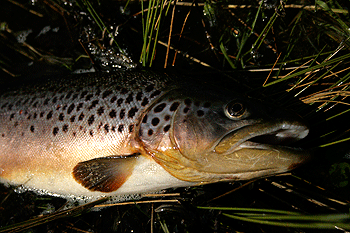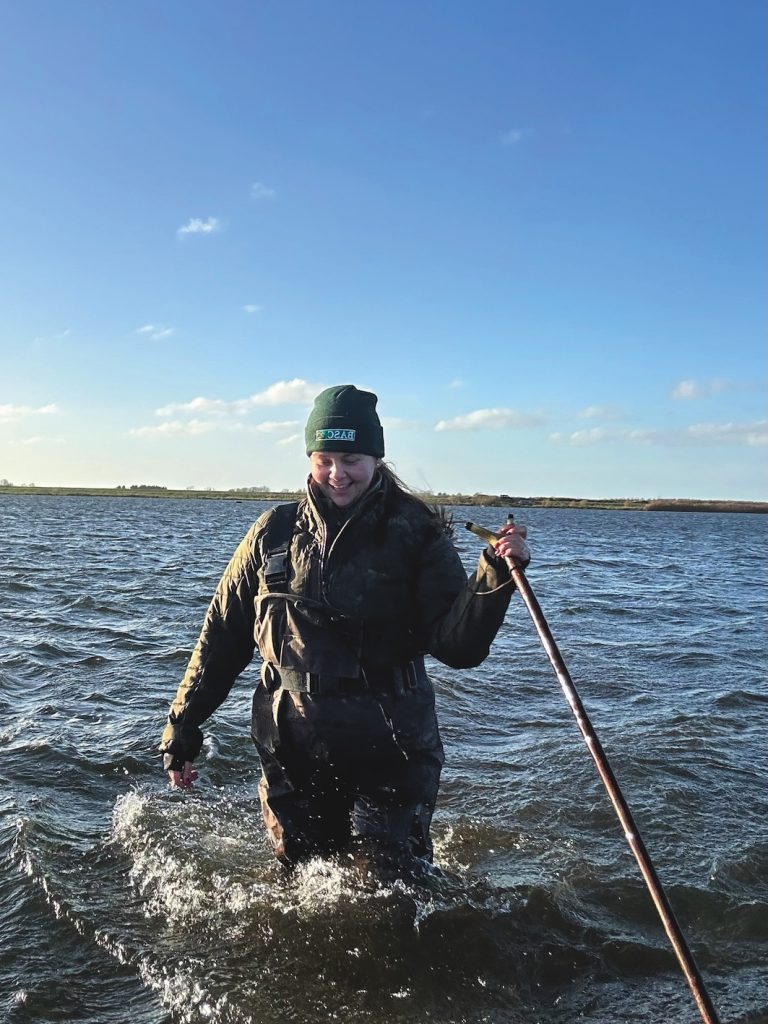Win CENS ProFlex DX5 earplugs worth £1,149 – enter here
Ferox trout: Scotland’s mysterious predator
<strong>Mystery surrounds the origins of Scotland's predatory deep-water trout</strong>

Encircled by towering peaks of ancient granite, the dark waters of Scotland?s remote post-glacial lochs have long served as a source of myth and legend. Tales woven in antiquity by the Celtic bards warn of the horse-headed kelpie, a nightmarish beast said to dwell within the peaty depths, far beyond the reach of the sun?s rays.
Myth, legend and the product of a fevered imagination perhaps, but predatory monsters do inhabit the deepest of these northern waters in the form of the magnificent and elusive ferox brown trout. Achieving weights likely to satisfy even the most ambitious angler, this piscivorous fish was a favourite quarry species of our Victorian and Edwardian forebears. It was first christened ferox ? meaning ferocious ? by the Scottish naturalist Sir William Jardine in 1835. Over the ensuing 178 years, one might have expected considerably more to have become known about the life cycle of this large lake-dwelling trout, but until surprisingly recently little was known of the origins and ecology of this particular member of the genus Salmo.
Defined as a large, long-lived, predatory brown trout inhabiting certain deep, glacier-formed lakes, ferox has a range extending throughout Scotland, Ireland, Scandinavia and western Russia. A key factor, considered vital for the presence of ferox in any water, is an abundance of smaller prey fish, such as Arctic charr, roach and even brown trout. For reasons not fully understood, once this cannibalistic example of Salmo trutta exceeds a length of 30cm to 35cm, it begins to feed almost exclusively on other fish.
To understand better the ecology of this inhabitant of Scotland?s deepest lochs, I contacted Argyll Fisheries Trust biologist Alan Kettle-White. Alan has made a detailed study of ferox within the waters of Loch Awe. A keen angler, he landed a ferox weighing a staggering 30lb 10oz, on rod and line, in May 2012.
Ferox was once classified as Salmo ferox ? an entirely separate species from brown trout (Salmo trutta) ? so I was keen to know whether Alan considered the two species to be quite different. He said that even with the advantages of today?s genetic testing techniques, scientific opinion is still greatly divided upon the subject.
It is possible that certain brown trout within a body of water may become predatory upon reaching a particular size, solely due to environmental circumstances and food availability. Why such a dietary switch should occur in some fish, but not in others, is not clear. But whatever the cause, the change from a diet of insects and invertebrates to that of fish results in a rapid increase in size and weight, as well as longevity. Indeed, a specimen of ferox taken from Loch Killin, in Inverness-shire, was discovered to be 23 years old. Others captured in Lochs Garry and Rannoch were 17 and 18 years old respectively.
Alan believes that ferox living in Loch Awe have more in common genetically with ferox in Lochs Garry, Laggan and Rannoch than they do with smaller brown trout dwelling within their own home water. There is even a genetic similarity between these Scottish ferox and those found in the great Irish loughs Corrib, Mask and Erne.
This large brown trout also demonstrates different spawning behaviour from that of its smaller brethren ? those in Loch Awe choose to spawn separately in the outflowing river Awe. This suggests that following the last ice age, the ferox brown trout colonised northern lakes from a wholly distinct gene pool. But the truth of the matter seems to be as obscure as the dark waters the fish inhabits.
If its origins remain uncertain, both the research group Ferox 85 and the Fisheries Research Services Laboratory ? based at Faskally in Perthshire ? have
done much to clarify the movements and habits of ferox. Data collected from specimens fitted with radio tracking and acoustic tags in Lochs Garry and Rannoch showed that the horizontal movements of this fish ranged widely during the day. Ferox were seen to be non-territorial and actively sought out prey species in open water. This is in stark contrast to that other loch predator, the pike, which remains in its home range, relying on ambush to secure its prey. To demonstrate further just how far ferox may travel, one particular fish in Loch Rannoch was recaptured 6km from its release point 19 days after tagging.
Acoustic tracking also gives a unique insight into the depths of water that ferox inhabit. During the day fish spent most of the time in water less than 10m deep, but they were recorded making sustained dives down to depths of 30m, where, presumably, they were hunting shoals of deep-dwelling charr. During the hours of darkness, the fish moved into the shallower water around the margins of the loch ? intriguing behaviour for a creature associated with deep water.
Tackle and bait
Alan has gained considerable experience in capturing ferox on rod and line, so I was interested to learn more about his angling methods. He recommends the use of salmon spinning rods and reels, and suggests that either a small baitfish or artificial lure be trolled or trailed behind a slow-moving boat. He favours the use of fairly heavy tackle and leaders of up to 20lb breaking strain, because this combination shortens the time required to play a ferox. This approach prevents the fish from becoming entirely exhausted, thus increasing its chances of survival when released.
Alan recommends that a range of fishing depths be explored, adding that with the use of weighted-down rigs one can reliably work bait at any chosen setting. Interestingly, he pointed out that most ferox are encountered while trolling at depths of around 10 or 12m. Pike may also occasionally be hooked while using this technique, but only ever when working the loch?s shallower margins.
For reasons which remain unclear, ferox fishing seems to be most productive either early or late in the season (15 March ? 30 September on most waters), with several decent specimens almost always being landed on the opening day.
The current UK rod-caught record for ferox is held by Brian Rutland, who landed a fish weighing 31lb 12oz from Loch Awe, in Argyll, on 15 March 2002. Every season, the dark waters of Scotland?s deepest lochs yield up further, huge brown trout, so it must only be a question of time before the present record is broken. No one truly knows what the maximum achievable weight of erox could be, but perhaps for a tantalising indication, we might look to the words of English physician and naturalist John Berkenhout. In his Synopsis of the Natural History of Great Britain and Ireland (1789), he categorises ferox with words likely to raise the pulse of any angler: ?Lake trout. Sometimes 50 or 60lb. Probably a distinct species. In the north.?
Catch and release
As almost all Scottish ferox are found in cold, nutrient-poor lochs, it seems probable that their overall population is low and therefore vulnerable to over-exploitation. When a fish may have taken two decades to reach specimen size, it?s only sensible that a policy of catch and release be observed. Without the benefit of the digital camera, our forebears could be forgiven for having a trophy ferox stuffed, mounted and displayed in a glass case. Far better today if we photograph our catch before releasing the fish back into the waters of the loch, there to increase in size and add to its unique gene pool.
But the threat of increased angling is not the only danger to face this fragile population of brown trout. Ferox spawning locations are usually limited and specific ? typically a deep outflowing or inflowing river ? and therefore highly vulnerable to pollution, hydro-electric development, or other ecological damage. The increased planting of coniferous forests may also raise the acidity level of feeder burns, thus reducing the overall hatch rate of ferox eggs.
Alan pointed out that because ferox are generally long lived, by the time the scientific community becomes aware of such ecological damage, it would probably be too late and the negative effects irreversible. As the presence of ferox within a loch depends upon a fine ecological balance, one could easily project how the introduction of invasive alien species might have disastrous consequences for a predator so dependent on an unbroken food chain. The alien filter-feeding zebra mussel ? first discovered in Northern Ireland in the late 1990s ? is known to have changed significantly the plankton level and fish population of Lough Erne. If this pernicious mollusc continues to alter the ecosystem, it could pose a serious threat to the future of ferox in Ireland.
In addition, the introduction of fertile hatchery-bred trout into waters where ferox are present could inadvertently threaten the genetic purity and ancient lineage of this predatory brown trout. With an enormous sporting potential for future generations of anglers, and as a barometer to the well-being of some of our country?s finest natural lakes, ferox is a precious natural resource that deserves our respect and protection.
Related Articles
Get the latest news delivered direct to your door
Subscribe to Shooting Times & Country
Discover the ultimate companion for field sports enthusiasts with Shooting Times & Country Magazine, the UK’s leading weekly publication that has been at the forefront of shooting culture since 1882. Subscribers gain access to expert tips, comprehensive gear reviews, seasonal advice and a vibrant community of like-minded shooters.
Save on shop price when you subscribe with weekly issues featuring in-depth articles on gundog training, exclusive member offers and access to the digital back issue library. A Shooting Times & Country subscription is more than a magazine, don’t just read about the countryside; immerse yourself in its most authoritative and engaging publication.







